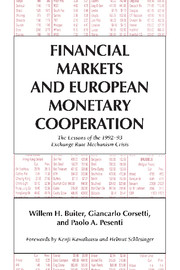 Financial Markets and European Monetary Cooperation
Financial Markets and European Monetary Cooperation Book contents
- Frontmatter
- Contents
- Forewords by Kenji Kawakatsu and Helmut Schlesinger
- Acknowledgments
- 1 Introduction
- 2 Exchange rate stability in Europe: A historical perspective
- 3 The unfolding of the 1992–93 ERM crisis
- 4 Financial markets and ERM credibility
- 5 Modelling currency crises
- 6 A Center–Periphery model
- 7 Unilateral pegs and escape clauses: The role of domestic credibility
- 8 Policy coordination and currency crises
- 9 What caused the system to crumble?
- 10 Rebuilding the system: What next?
- References
- Index
3 - The unfolding of the 1992–93 ERM crisis
Published online by Cambridge University Press: 06 July 2010
- Frontmatter
- Contents
- Forewords by Kenji Kawakatsu and Helmut Schlesinger
- Acknowledgments
- 1 Introduction
- 2 Exchange rate stability in Europe: A historical perspective
- 3 The unfolding of the 1992–93 ERM crisis
- 4 Financial markets and ERM credibility
- 5 Modelling currency crises
- 6 A Center–Periphery model
- 7 Unilateral pegs and escape clauses: The role of domestic credibility
- 8 Policy coordination and currency crises
- 9 What caused the system to crumble?
- 10 Rebuilding the system: What next?
- References
- Index
Summary
Toward the crisis
German reunification
German reunification was an unprecedented economic and political event: the integration of two national economies that had undergone postwar reconstruction under two very different systems, ending up with a substantial gap in productive capacities and standards of living. It would have been a difficult enterprise at the best of times. It was turned into a textbook example of macroeconomic mismanagement, eventually resulting in the adoption of a monetary–fiscal policy mix that was undesirable even for Germany internally, let alone for the EC as a whole.
First, the German Chancellor kept his electoral promise not to finance the massive transfer of resources to the Eastern part of the country by asking Western Germans to pay additional taxes. Nor were there significant cuts in other spending items in the budget. In 1991, the net transfer of West German public funds to East Germany was as high as 139 billion D-mark. To get a sense of this magnitude, it can be compared to West German private saving for that year of 260 billion D-mark. This net transfer reached 180 billion D-mark the following year. The rate of growth of West German public sector indebtedness, which averaged around 5% in the second half of the Eighties, rose to 13.4% and 11.2% in 1990 and 1991, respectively.
Second, with the creation of a Monetary, Economic, and Social Union in May 1990, GDR marks could be converted into D-mark on a 1:1 or 2:1 basis.
- Type
- Chapter
- Information
- Financial Markets and European Monetary CooperationThe Lessons of the 1992–93 Exchange Rate Mechanism Crisis, pp. 38 - 66Publisher: Cambridge University PressPrint publication year: 1998
